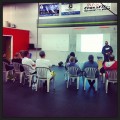CrossFit’s First Fitness Standard
There are ten recognized Fitness Domains. They are cardiovascular/respiratory endurance, stamina, strength, flexibility, power, coordination, agility, balance and accuracy. You are as fit as you are competent in each of these ten skills. A regimen develops fitness to the extent that it improves each of these ten skills
Importantly, improvements in endurance, stamina, strength and flexibility come about through training. Training refers to activity that improves performance through measureable organic change in the body. By contrast, improvements in coordination, agility, balance and accuracy come about through practice. Practice refers to activity that improves performance through changes in the nervous system. Power and speed are adaptations of both training and practice.
CrossFit’s Second Fitness Standard
The essence of this model is the view that fitness is about performing well at any and every task imaginable. Picture a hopper loaded with an infinite number of physical challenges where no selective mechanism is operative and being asked to perform fetes randomly drawn from the hopper. This model suggests that your fitness can be measured by your capacity to perform well at these tasks in relation to other individuals.
The implication here is that fitness requires an ability to perform well at all tasks, even unfamiliar tasks, tasks combined in infinitely varying combinations. In practice this encourages the athlete to disinvest in any set notions of sets, reps, exercise, order of exercises, routines, periodization etc. Both sport and nature frequently provide largely unforeseeable challenges; train for that by striving to keep the training stimulus broad and constantly varied.
CrossFit’s Third Fitness Standard
There are three metabolic pathways that provide the energy for all human action. These “metabolic engines” are known as the phosphagen pathway, the glycolytic pathway and the oxidative pathway.
The first, the phosphagen, dominates the highest-powered activities; those that last less than about ten seconds. The second pathway, the glycolytic, dominates moderate-powered activities; those that last up to several minutes. The third pathway, the oxidative, dominates low-powered activities; those that last in excess of several minutes.
Total fitness, the fitness that CrossFit promotes and develops, requires competency and training in each of these three pathways or engines. Balancing the effects of these three pathways largely determines the how and why of the metabolic conditioning or “cardio” that we do at RAW CrossFit.
Favoring one or two to the exclusion of the others and not recognizing the impact of excessive training in the oxidative pathway are arguably the two most common faults in fitness training.
Adapted from “What is Fitness?” found in The CrossFit Journal, October 2002 issue written by Greg Glassman.
For additional information read CrossFit Foundations.













.gif)



